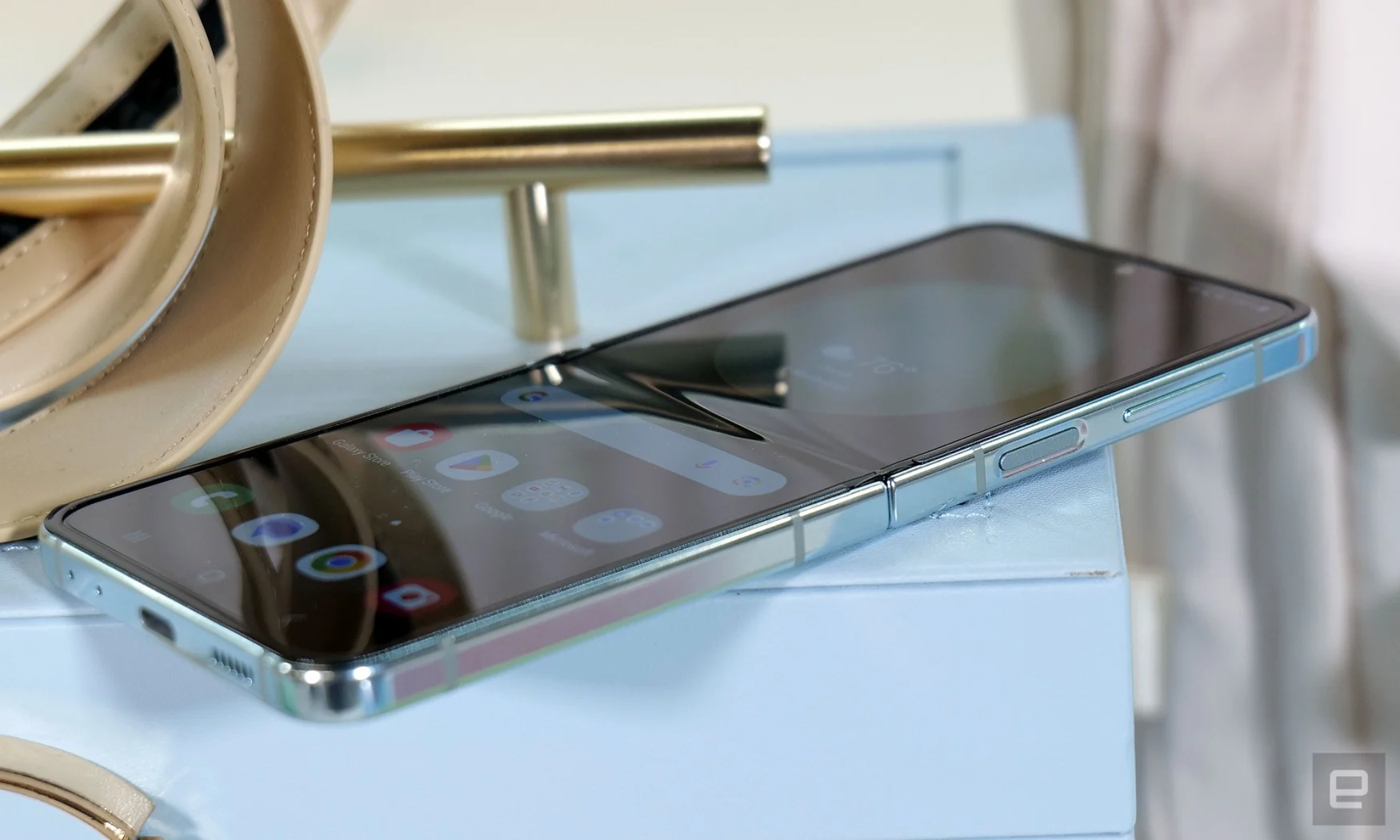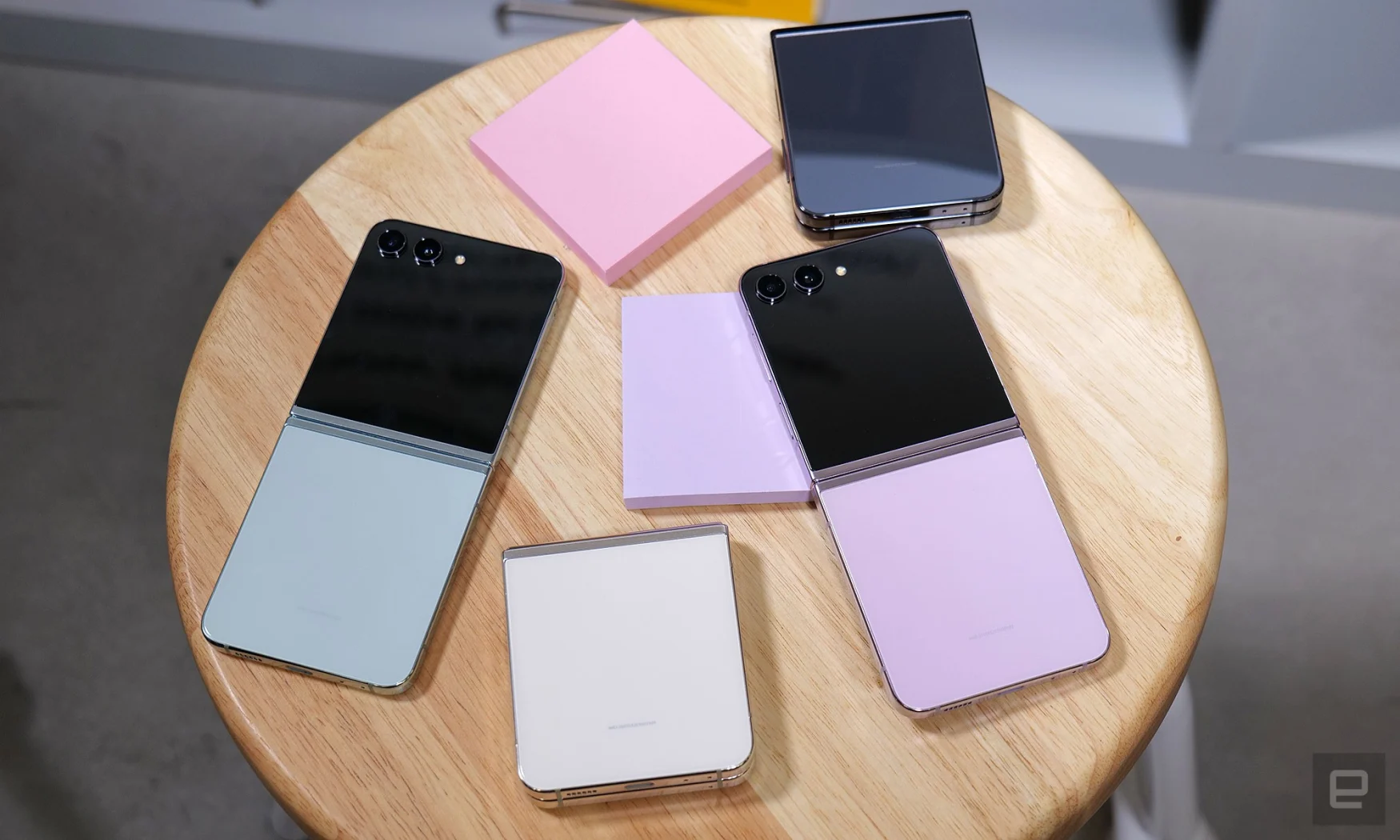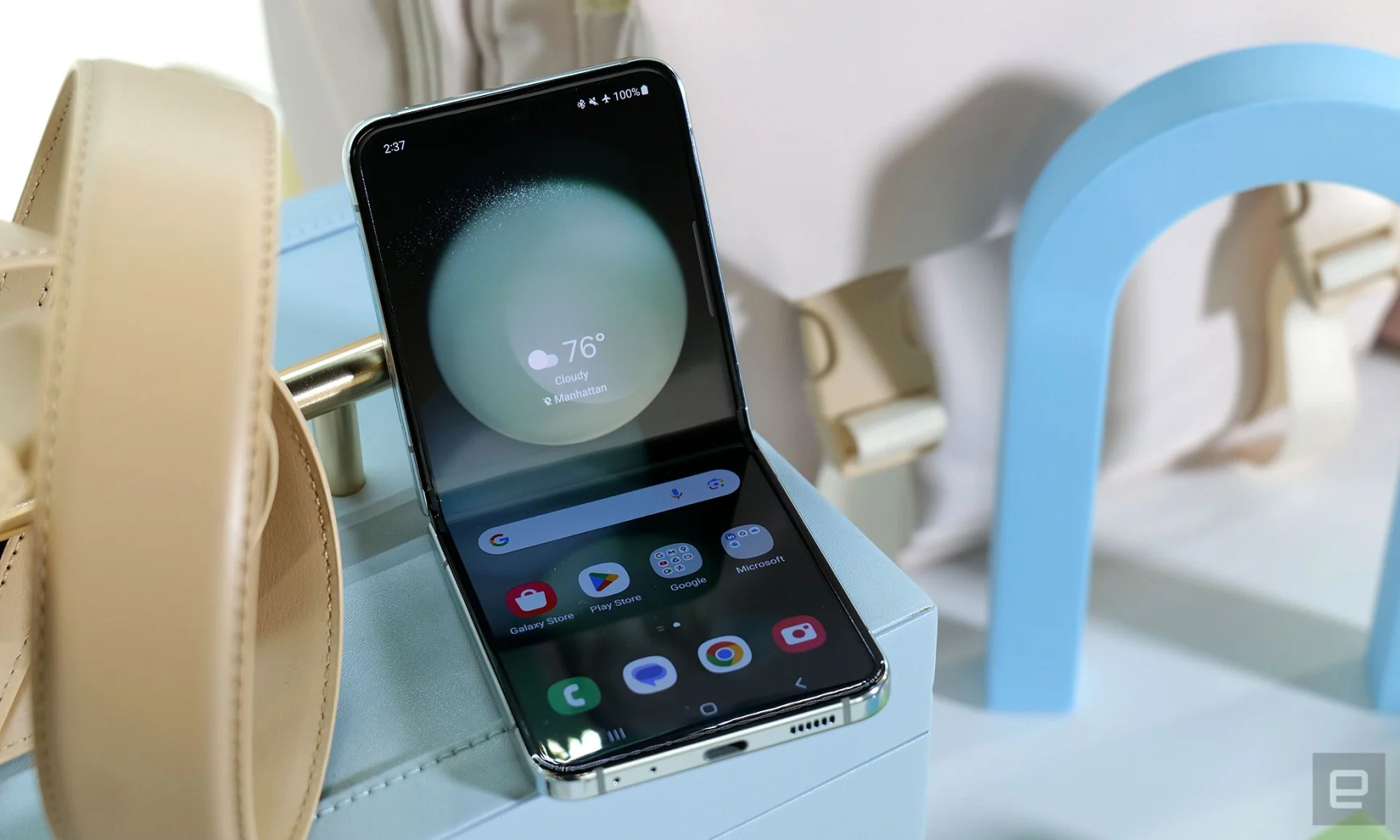Samsung Galaxy Z Flip 5 hands-on: A larger external display holds promise
Cameras and Flex Mode
One of the best things about having a larger cover screen is how much more useful it is as a viewfinder. Most foldable phones let you use the secondary display to preview shots you take with the rear cameras, which are almost always superior to the interior sensors. On the Z Flip 4’s tiny sliver of a panel, it was hard to see what I was recording. This year, you’ll actually be able to view your entire shot before taking it. Like before, you can also swipe to change modes and lenses, as well as pinch to zoom in on your subjects.
The camera hardware hasn’t really changed. Samsung applied a different coating to the primary lens and tweaked some of the software to enable greater digital zoom. But on paper the Flip 5 has the same pair of 12-megapixel main and ultra-wide cameras as its predecessor. Inside, the 10-megapixel selfie camera has a slightly larger aperture of f/2.2 (compared to last year’s f/2.4), which should make for brighter, clearer shots. Without a side by side comparison, though, it’s tough to tell how noticeable of a difference it will make.
It’s not like you’ll want to use the internal camera much, since you can easily frame up shots with the outside sensors now. But it could come in handy for video calls or livestreams, in which case you might find it handy to prop the phone up by folding it at a 90-degree angle and sitting it up on a table.
When you fold the Flip 5 but don’t completely shut it, Flex Mode kicks in (on compatible apps). We’ve seen this on older models — apps like YouTube, Camera and Gallery will adapt their layouts by presenting content on the top half and controls on the bottom. This year, though, Samsung added more shortcuts to the Flex panel that appears on the lower half (if you enable the feature). When the Flip 5 is flexed, a small icon shows up on the bottom left that will bring up the navigational panel and move the rest of the app to the top portion of the screen.
Photo by Sam Rutherford
Here, you can have settings that make one-handed use slightly easier. You can press a button to bring down the notifications shade instead of having to reach your thumb all the way to the top. You can also take a screenshot using a shortcut or bring up a touchpad for exploring the top half of the screen with a cursor. I didn’t get to spend a lot of time with the updated Flex Mode at the hands-on session, but I know I was less than impressed when I reviewed the Flip 4 last year, after initially being excited about the feature. This time around, I won’t be so easily fooled (I hope).
New hinge, old crease
One of the more significant changes to the Z Flip line is Samsung’s new “Flex Hinge.” I’m still a little miffed about the obsession with calling everything “Flex” this and “Flex” that and honestly “Flex Hinge” sounds like a dating app exclusively for people showing off their biceps. But it’s just a marketing name for Samsung’s redesigned hinge with a dual-rail structure that is supposed to help diffuse impact.
Putting aside my distaste for the name (once more), I have to admit the new mechanism seems solid. The phone closes, without a noticeable gap like the Flip 4. It still felt as sturdy as older models, holding itself up at various angles from about 20 degrees to 160 degrees or so. Those of you who found the gap irritating should be relieved.

Photo by Sam Rutherford
People who hated the crease in the middle of the internal screen, though, will be disappointed. When I held up the Flip 5 next to a Flip 4 that I brought, the degree to which their flexible displays wrinkled was pretty much identical. But in my years of testing foldable phones, creases have never been anything more troublesome than an aesthetic quirk. It won’t get in the way of actually using the device.
Processor, storage and other specs
In fact, you’ll probably enjoy the Flip 5’s internal screen, which is a 6.7-inch Full HD AMOLED panel that refreshes at 120Hz. The 22:9 aspect ratio is slightly taller than your average smartphone, but most apps run fine. Powering everything this year is the Snapdragon 8 Gen 2 for Galaxy chipset that’s also in the Galaxy S23 series. Samsung doubled the storage for the Flip 5, so the base model gets 256GB (instead of last year’s 128GB) while costing the same. That’s a nice touch, and might even make me forgive the company’s overuse of the word Flex.
Also in Samsung’s favor is this year’s selection of colors. You can choose from the standard black (graphite), cream, lavender or this generation’s signature color — mint. It’s a similar shade of green to the one Apple used for the iPhone 12, which is still one of my favorite colors ever used on a handset. Plus, I was beginning to find the Flip 4’s Bora Purple a little dated.

Photo by Sam Rutherford
Pretty much everything else about the Flip 5 is the same as its predecessor. The battery size is the same at 3,700mAh, and it recharges at the same rate as well. That’s a little disappointing, considering the Flip 4 already struggled to last an entire day. But, perhaps the new larger cover screen is useful enough that you can conserve battery life by using the internal display less.
The Flip 5 also retains the same IPX8 water-resistance rating as the Flip 4, though it uses the newer Gorilla Glass Victus 2 covering on the outside. The handsets didn’t feel very different to me, so any changes here are pretty subtle.
Frankly, the biggest difference to the Flip 5 is its Flex Window, followed by its Flex Hinge. Some tweaks to Flex Mode round up the set of upgrades Samsung is bringing to its smaller foldable this year. Though I’m a fan of roomier screens on the outside of flip-style foldables, I can’t help but wonder: is Samsung limiting the Flip 5’s potential with its reluctance to run full Android on the small display?
That’s a question I can only answer after spending more time with a review unit and evaluating things like camera quality, battery life and real-world performance. For now, Samsung has brought us hardware that holds a lot of promise. The Galaxy Z Flip 5 starts at $999 and is available for pre-order at Samsung and Amazon starting today.
All products recommended by Engadget are selected by our editorial team, independent of our parent company. Some of our stories include affiliate links. If you buy something through one of these links, we may earn an affiliate commission. All prices are correct at the time of publishing.
Cameras and Flex Mode
One of the best things about having a larger cover screen is how much more useful it is as a viewfinder. Most foldable phones let you use the secondary display to preview shots you take with the rear cameras, which are almost always superior to the interior sensors. On the Z Flip 4’s tiny sliver of a panel, it was hard to see what I was recording. This year, you’ll actually be able to view your entire shot before taking it. Like before, you can also swipe to change modes and lenses, as well as pinch to zoom in on your subjects.
The camera hardware hasn’t really changed. Samsung applied a different coating to the primary lens and tweaked some of the software to enable greater digital zoom. But on paper the Flip 5 has the same pair of 12-megapixel main and ultra-wide cameras as its predecessor. Inside, the 10-megapixel selfie camera has a slightly larger aperture of f/2.2 (compared to last year’s f/2.4), which should make for brighter, clearer shots. Without a side by side comparison, though, it’s tough to tell how noticeable of a difference it will make.
It’s not like you’ll want to use the internal camera much, since you can easily frame up shots with the outside sensors now. But it could come in handy for video calls or livestreams, in which case you might find it handy to prop the phone up by folding it at a 90-degree angle and sitting it up on a table.
When you fold the Flip 5 but don’t completely shut it, Flex Mode kicks in (on compatible apps). We’ve seen this on older models — apps like YouTube, Camera and Gallery will adapt their layouts by presenting content on the top half and controls on the bottom. This year, though, Samsung added more shortcuts to the Flex panel that appears on the lower half (if you enable the feature). When the Flip 5 is flexed, a small icon shows up on the bottom left that will bring up the navigational panel and move the rest of the app to the top portion of the screen.

Photo by Sam Rutherford
Here, you can have settings that make one-handed use slightly easier. You can press a button to bring down the notifications shade instead of having to reach your thumb all the way to the top. You can also take a screenshot using a shortcut or bring up a touchpad for exploring the top half of the screen with a cursor. I didn’t get to spend a lot of time with the updated Flex Mode at the hands-on session, but I know I was less than impressed when I reviewed the Flip 4 last year, after initially being excited about the feature. This time around, I won’t be so easily fooled (I hope).
New hinge, old crease
One of the more significant changes to the Z Flip line is Samsung’s new “Flex Hinge.” I’m still a little miffed about the obsession with calling everything “Flex” this and “Flex” that and honestly “Flex Hinge” sounds like a dating app exclusively for people showing off their biceps. But it’s just a marketing name for Samsung’s redesigned hinge with a dual-rail structure that is supposed to help diffuse impact.
Putting aside my distaste for the name (once more), I have to admit the new mechanism seems solid. The phone closes, without a noticeable gap like the Flip 4. It still felt as sturdy as older models, holding itself up at various angles from about 20 degrees to 160 degrees or so. Those of you who found the gap irritating should be relieved.

Photo by Sam Rutherford
People who hated the crease in the middle of the internal screen, though, will be disappointed. When I held up the Flip 5 next to a Flip 4 that I brought, the degree to which their flexible displays wrinkled was pretty much identical. But in my years of testing foldable phones, creases have never been anything more troublesome than an aesthetic quirk. It won’t get in the way of actually using the device.
Processor, storage and other specs
In fact, you’ll probably enjoy the Flip 5’s internal screen, which is a 6.7-inch Full HD AMOLED panel that refreshes at 120Hz. The 22:9 aspect ratio is slightly taller than your average smartphone, but most apps run fine. Powering everything this year is the Snapdragon 8 Gen 2 for Galaxy chipset that’s also in the Galaxy S23 series. Samsung doubled the storage for the Flip 5, so the base model gets 256GB (instead of last year’s 128GB) while costing the same. That’s a nice touch, and might even make me forgive the company’s overuse of the word Flex.
Also in Samsung’s favor is this year’s selection of colors. You can choose from the standard black (graphite), cream, lavender or this generation’s signature color — mint. It’s a similar shade of green to the one Apple used for the iPhone 12, which is still one of my favorite colors ever used on a handset. Plus, I was beginning to find the Flip 4’s Bora Purple a little dated.

Photo by Sam Rutherford
Pretty much everything else about the Flip 5 is the same as its predecessor. The battery size is the same at 3,700mAh, and it recharges at the same rate as well. That’s a little disappointing, considering the Flip 4 already struggled to last an entire day. But, perhaps the new larger cover screen is useful enough that you can conserve battery life by using the internal display less.
The Flip 5 also retains the same IPX8 water-resistance rating as the Flip 4, though it uses the newer Gorilla Glass Victus 2 covering on the outside. The handsets didn’t feel very different to me, so any changes here are pretty subtle.
Frankly, the biggest difference to the Flip 5 is its Flex Window, followed by its Flex Hinge. Some tweaks to Flex Mode round up the set of upgrades Samsung is bringing to its smaller foldable this year. Though I’m a fan of roomier screens on the outside of flip-style foldables, I can’t help but wonder: is Samsung limiting the Flip 5’s potential with its reluctance to run full Android on the small display?
That’s a question I can only answer after spending more time with a review unit and evaluating things like camera quality, battery life and real-world performance. For now, Samsung has brought us hardware that holds a lot of promise. The Galaxy Z Flip 5 starts at $999 and is available for pre-order at Samsung and Amazon starting today.
All products recommended by Engadget are selected by our editorial team, independent of our parent company. Some of our stories include affiliate links. If you buy something through one of these links, we may earn an affiliate commission. All prices are correct at the time of publishing.
